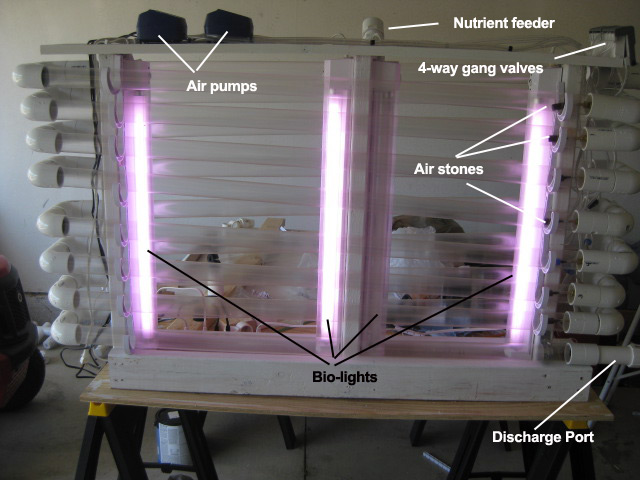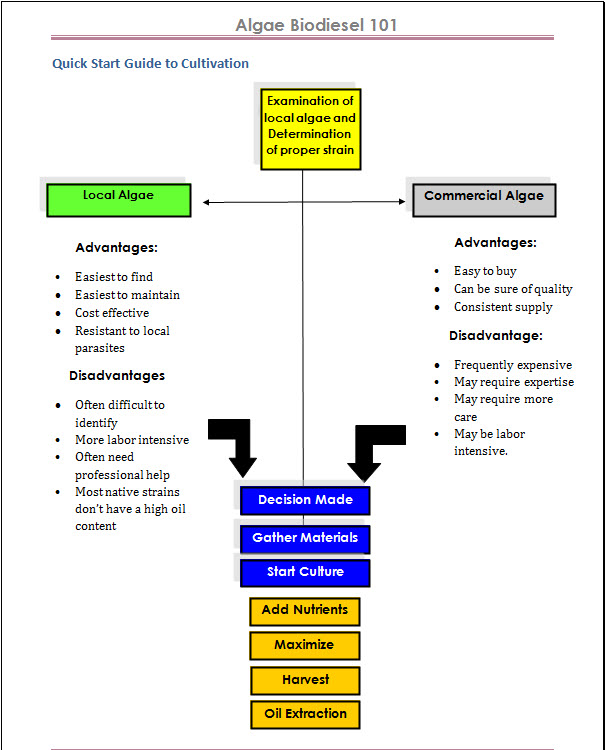
Cultivation in algae bioreactors, or “PBR’s” are tanks or closed systems in which algae are grown. Algal culture which is grown can have a single algae strain or contain a number of strains. It depends on the type of end product desired.
Controlled amounts of water, nutrients and carbon dioxide are provided in the culture medium. Oxygen liberated as the result of photosynthesis is removed from the tanks. Sunlight is provided either directly with transparent tank walls or light tubes are placed which channel sunlight.
Algae bioreactors are also optimized to maximize algae cultivation.
In closed systems, algae growth conditions can be regulated much easily and precisely by engineers. Closed systems include photo bioreactors for producing species of photosynthetic algae. Traditional bioreactors made up of closed tanks are used for species (e.g. cyanobacteria) which do not require sunlight.
Why Use an Algae Bioreactor?

When it comes to growing algae you have two choices in life…open ponds or algae bioreactors.
Depending on your application, volume of algae needed, and climate will determine which method will work the best for you.
An algae bioreactor (PBR) can be described as an enclosed, lighted, algal culture vessel designed for controlled production of algae. Photo bioreactors, have several major advantages over open ponds, they can:
- Prevent or minimize contamination
- Offer better control over existing conditions (pH, light, carbon dioxide, temperature).
- Prevent water evaporation,
- Lower carbon dioxide losses due to out gassing,
- Permit higher cell concentrations.
- Allow you to grow algae in any climate
However with the advantages come disadvantages as well. Namely,
- Cost
- Size and scope
- Technical expertise
Let’s take a look at each of these in more detail before we begin…
Algae Bioreactors Advantages and Disadvantages
Advantages:

- Prevent contamination: One of the biggest problems with opens ponds (in my view anyway) is they are susceptible to contamination from invading and/or native species. In a PBR all inputs are completely controlled by you, not chance or nature. This is a HUGE advantage.
- Allow you to grow algae in any climate: This is one of the main reasons for a PBR. It allows you to grow algae easily and cheaply in almost any climate. Open ponds are an unacceptable alternative in many colder climates.
- Bioreactors offer better control over existing conditions: Since you’re controlling all the inputs, you can also (better) control the existing conditions of your algal experiments. Meaning climate, light, temperature, Ph balance, nutrients, etc. Many times this isn’t possible in an open pond situation. For example it is hard to control the amount of sunlight in a given location. However with a PBR it is as simple as resetting a timer.
- Prevent water evaporation: Water evaporation in an open pond can be difficult situation to control. Where water is scarce this makes open ponds an unacceptable choice.
- Lower carbon dioxide losses: If you have a unlimited source of waste carbon dioxide this isn’t a problem, however most home users aren’t in a situation of living next to a power plant…they have to buy it in canisters. In order to minimize costs, this becomes a consideration.
- Permit higher cell concentrations: Because you’re controlling the parameters of the PBR, you can also control the density of your cell colonies. While possible in an open pond, it is much easier in a PBR.
Disadvantages:

- Cost: Until now, algae bioreactors were considered the realm of corporations due to the high cost of fabrication. Indeed the high cost of acrylic tubes, especially as the price of oil increases, is enough to give one pause. The key to controlling the cost of PBR’s is in “Yankee ingenuity.”
- Sure, it’s always possible to complicate things and charge extra. No problem there. However to use existing inexpensive, local resources to create a PBR the knowledge has been non-existent. Until now. That is one of the main reasons for producing this book.
- Size and scope: For the most part, algae bioreactors have been confined to laboratories with relatively few being fabricated for large scale production. That is now changing. The size and scope of your algae bioreactor is also dependent on your application. Many (most) uses don’t require a large scale PBR…health food supplements, for example. You can easily make all the Spirulina and/or chlorella your family would need with a small PBR. Algae bio fuels for example, go to the opposite end of the spectrum. Here you need to produce a large amount of algae to be successful.
If you're interested in learning how to build an inexpensive small to medium scale bioreactors for your home or lab Building Algae PhotoBioreactors at Home is the best book available on the subject.
You also be interested in...

The Algae Biodiesel Process
The algae biodiesel process is fairly straight-forward, however the devil is in the details. Read More

The Two Biggest Mistakes in Algae Biofuels
Without a doubt, The Two Biggest Mistakes I saw as a biofuel consultant in advanced biofuels were...Read More

Algae Biofuels: Separating Myth From Fact
Lot so wild stories and wild claims being made in the algae biofuels space. Sifting through the flotsam of cyberspace isn't easy... Read More
The Algae Revolution Has Begun
I learned more from your eBook than spending $6,000...
Dear David,
I have learned more from your e-book than spending $6,000 going to the Algae World 2009 Conference in Rotterdam. Do you have the same manual for Jatropha? Many thanks,
Thanks in advance
Perpetual Prosperty Pumps, Africa



